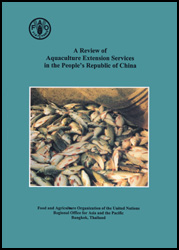
by
Song Zhiwen
FAO Consultant
RAP Publication 1997/34
REGIONAL OFFICE FOR ASIA AND THE PACIFIC
FOOD AND AGRICULTURE ORGANIZATION OF THE UNITED NATIONS
Bangkok, Thailand
Table of Contents
|
The designations employed and the presentation of materials in this publication do not imply the expression of any opinion whatsoever on the part of the Food and Agriculture Organization of the United Nations concerning the legal status of any country, territory, city or area or of its authorities, or concerning the delimitation of its frontiers or boundaries. Opinions expressed in this publication are those of the author alone and do not imply any opinion whatsoever on the part of FAO. |
NOTICE OF COPYRIGHT
All rights reserved. No part of this publication may be reproduced, stored in a retrieval system, or transmitted in any form or by any means, electronic, mechanical, photocopying or otherwise, without the prior permission of the copyright owner. Applications for such permission, with a statement of the purpose and extent of the reproduction, should be addressed to the Regional Aquaculture Officer, FAO Regional Office for Asia and the Pacific, Maliwan Mansion, Phra Athit Road, Bangkok 10200, Thailand.
© FAO 1997
List of abbreviations and acronyms
1. Aquaculture extension services in the People's Republic of China
2. Fisheries and aquaculture institutions
2.1 Development and management
2.2 Research
2.3 Education and training
3. Fisheries and aquaculture extension services
3.1 Extension services organisation
3.2 Extension policies, plans and programmes
3.3 Methods and systems of extension
3.4 Transfer of culture technology
3.5 Input supplies, equipment and subsidies
3.6 Control mechanisms
3.7 Extension and research linkage
3.8 Non-governmental organisations (NGOs) in extension
4. Production, marketing and economics
5.1 Employment
5.2 Additional family income
5.3 Nutritional benefits
5.4 Progress, constraints and potentials